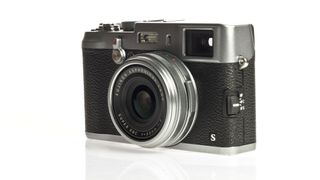Why you can trust TechRadar
As with the X-Pro1, Fuji claims that the X100S's sensor design enables the compact camera to compete with full-frame cameras for image quality. Our tests reveal that this claim isn't too wide of the mark, and the Fuji X100S is capable of resolving an impressive amount of detail.
Noise is also well controlled, with no sign of coloured speckling in JPEGs or raw files taken at the highest sensitivity settings. In fact, even at ISO 12,800 and 25,600 there's little colour speckling visible in raw files viewed at 100% on the screen. But there is some subtle mottling of green and red when the noise reduction is turned off in the supplied SilkyPix raw conversion software.
The details are softened at the highest ISO settings and there's a fair amount of luminance noise visible, but shots taken at ISO 6400 still look good when sized to make A3 (16.5 x 11.7 inch) prints.

We have no major complaints about the Fuji X100S's autofocus system. When shooting outside in daylight it manages to get the subject sharp in most situations. Even in low light the system copes pretty well, and it only struggles in very dark conditions.
In single AF mode the camera focuses the lens quickly, but there's still discernable back and forwards movement, albeit very swift, in most situations. That said, we found it was fast enough to capture relatively slow moving subjects.
The camera's continuous autofocus mode is also fairly quick and smooth, but its usefulness is diminished by the fact that the AF point is locked to the centre of the frame.

On the whole the FujiX100S's general purpose metering system performs well, but we found there were quite a few situations in which the images looked better when the exposure compensation dial was used to reduce the exposure by 1/3EV. When shooting a cityscape under a blue sky, however, we found that the exposure needed increasing by 1/3 stop.
There are a collection of Film Simulation modes available on the Fuji X100S, but the default setting of Provia (Standard) is a good choice in many situations. However, we found that blue skies can sometimes be made to look a little over-saturated, and Astia mode may be preferable when subtler colour and contrast is required.
Just like the film emulsion that it simulates, the Velvia mode can also prove a little too vibrant. Blues and greens can be rendered unnaturally saturated and rather bright, so use it wisely.

We primarily used the Fuji X100S in Auto White Balance mode, and it copes well with many lighting situations, managing to produce a natural-looking result that reflects the atmosphere of the scene.
It was only the mixed lighting of a covered market that appeared to present any problem, with the resulting images having a slight yellow cast. Using a custom white balance setting resolves the issue, but correcting the cast only required a few seconds of work with Photoshop.
JPEGs from the Fuji X100S have a nice level of contrast so images look punchy and sharp, plus they can survive a fair amount of adjustment because there is detail in the shadows.

The raw files also have an impressively wide dynamic range of over 12EV at the lower sensitivity settings, so there's plenty of scope for editing.
The new advanced filters add an extra element of fun to shooting with the Fuji X100S. We particularly like the Selective Color filters that render all but the chosen colour black and white, and the Dramatic Tone filter that boosts saturation and contrast. Dramatic Tone is useful for injecting some interest into a city scene when the light is flat and dull, but it's not to everyone's taste.
Filter effects are very demanding of processing power and this can make the live view feed to the LCD or EVF rather sluggish, so there is a significant drop in the screen refresh rate.

Fortunately this isn't a major problem for the Fuji X100S, and it's relatively easy to track moving subjects when an advanced filter mode is activated. However, we noticed that when Dramatic Tone is selected the final image sometimes looks more dramatic than the preview image.
Although it is a comparatively wide-angle lens, the 23mm optic on the Fuji X100S doesn't suffer from excessive flare and barrel distortion is fairly well controlled, although some bowing of straight lines is to be expected.
Fringing isn't a major issue, with just the odd image suffering from a coloured halo to high-contrast edges. The most extreme example was seen when shooting the bright sky through thick iron bars from inside a dark room, but many lenses would have struggled with this situation.

